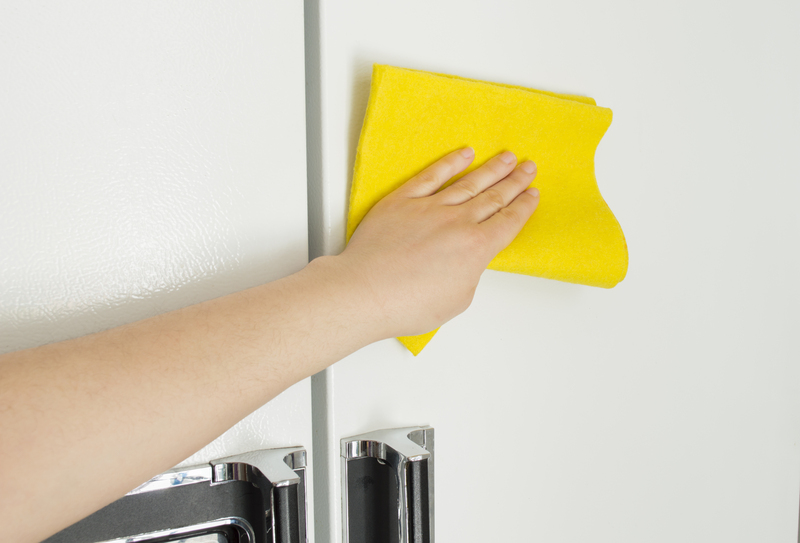The Ultimate Guide to Cleaning Sofa Covers Without Damage
Posted on 18/06/2025
Sofa covers are fantastic at protecting our couches from daily wear, spills, and stains. But while they safeguard the furniture, over time, they inevitably gather dust, dirt, and grime themselves. Knowing how to clean sofa covers without causing damage is essential to keeping both your living space and furniture looking their best. In this comprehensive guide, we'll explain everything you need to know about caring for your sofa covers, using both machine-washing and hand-washing methods, and we'll answer commonly asked questions on safe and effective cleaning.
Why Proper Cleaning of Sofa Covers Matters
Before jumping into the cleaning process, it's worth understanding why it's crucial to adopt gentle and effective methods for sofa cover cleaning. Regular, appropriate cleaning:
- Prevents fabric damage: Harsh chemicals and improper cleaning cycles can weaken or discolor materials.
- Extends lifespan: Keeping covers clean helps them last longer and maintain a fresher, newer look.
- Improves hygiene: Dust, bacteria, and allergens accumulate quickly, especially in households with pets and children.
- Enhances aesthetics: Vibrant, well-maintained covers instantly lift the appearance of your furnishings.

Understanding Your Sofa Cover Material
Every cover is made differently. Knowing your fabric type is essential to selecting the best cleaning methods. Some generic materials for sofa covers include:
- Cotton: Soft, breathable, and relatively easy to machine wash.
- Linen: Lovely natural look, but prone to shrinking if not handled correctly.
- Polyester / Microfiber: Durable, stain-resistant, and generally low-maintenance.
- Velvet: Luxurious and delicate, often requiring gentle hand-washing or special attention.
- Blend fabrics: Check the tag for cleaning symbols and guidance, as mixed fibers can affect washability.
Tip: Always inspect the label before cleaning. Most sofa covers have a care tag with symbols indicating cleaning options (wash, dry clean, bleach, etc.). Ignoring these can cause permanent damage!
Preparation Steps for Damage-Free Sofa Cover Cleaning
Effective sofa cover cleaning begins even before you apply water or detergent. Here's how you should prepare:
- Remove loose debris: Use a vacuum cleaner (with a soft brush attachment) to remove dust, crumbs, and pet hair.
- Spot test: Before applying any cleaner, test it on an inconspicuous area. This helps determine how the fabric reacts, preventing discoloration or spotting.
- Unzip and pre-treat stains: Most removable covers zip off. Treat visible stains with a suitable stain remover. Always dab gently--never rub!--to avoid fiber damage.
- Read and follow manufacturer instructions: Take note of any temperature or detergent restrictions.
Spot-Cleaning Sofa Covers: Immediate Care for Spills
For urgent spills or fresh stains, spot cleaning is your first line of defense. Here's how to act fast and safely:
- Blot, don't rub! Use a clean, dry microfiber cloth to gently blot up excess liquid.
- Apply a mild cleaner: Mix a few drops of gentle liquid detergent with lukewarm water. Dampen a soft cloth, dab the spot, then blot dry.
- Rinse and dry: If residue remains, wipe the area with a cloth dampened with plain water, then gently blot dry.
Important: Never use hot water or strong chemicals on stains, as these can set them or damage fabric fibers.
Machine Washing Sofa Covers Without Risk
Many removable covers are designed for machine washing, but following the right routine ensures you won't risk shrinking, fading, or tearing your covers. Here's the step-by-step process:
Step 1: Check the Label
Look for washability indicators, recommended temperatures, and optimum spin cycle speeds. If your tag says "dry clean only," do not attempt to machine wash.
Step 2: Prepare the Covers
- Zip up all zippers and fasten any Velcro straps to avoid snags.
- Turn covers inside out to protect the outer surface.
Step 3: Choosing Laundry Detergent
Pick a mild, liquid detergent--one that's free from bleach, brighteners, or harsh chemicals that can break down fibers or fade colors.
Step 4: Select the Washing Cycle and Temperature
- Use cold or lukewarm water unless the label explicitly says warm is acceptable.
- Opt for a gentle cycle (delicates/hand-wash setting) to reduce agitation.
Step 5: Drying Method
- Air dry whenever possible. Lay covers flat on a clean surface, or drape over a line away from direct sunlight
- Avoid tumble drying unless the label permits; high heat may cause shrinkage or fading.
Pro Tip: To avoid wrinkles, shake out covers straight after washing and smooth them with your hands before they dry.
Hand Washing Delicate Sofa Covers
If your covers are made of delicate or specialty fabrics (like velvet, silk, or those marked "hand wash only"), always use extra caution. Here is a safe method:
- Fill a large basin or bathtub with cool to lukewarm water.
- Dissolve a small amount of mild liquid detergent. Avoid powder formulas, which can be harder to rinse.
- Immerse the sofa cover, gently agitating it by hand for 2-5 minutes.
- Drain water, then rinse several times with cool water to remove all soap. Don't wring the fabric; instead, press gently between towels to absorb moisture.
- Reshape and air dry flat in a shaded area.
How to Remove Tough Stains from Sofa Covers
No matter how careful you are, accidents happen. For persistent stains, try these specialized tips:
- Wine, coffee, juice: Blot up as much liquid as possible, then treat with a mixture of 1 tbsp white vinegar, 1 tbsp dish soap, and 2 cups cold water. Dab, rinse, and blot dry.
- Grease or oil stains: Dust with baking soda or cornstarch to absorb oil. Let sit for 15 minutes, vacuum, then treat with dishwashing liquid.
- Ink stains: Lightly dab with rubbing alcohol (test first in hidden area). Blot, don't rub, until the stain lifts.
- Pet urine: Apply a mix of hydrogen peroxide, mild detergent, and water. Let soak, then rinse thoroughly.
Always finish by rinsing the area with clean water and blotting dry.
Dry Cleaning Sofa Covers: When and How?
Some sofa covers--especially those made from wool, silk, or specialty blends--should always be professionally dry cleaned. Attempting to hand- or machine-wash these can ruin the shape, texture, or color. Signs your cover must be dry cleaned:
- The care label is marked "Dry Clean Only".
- The fabric is expensive, antique, or highly textured.
- The color runs even during a spot test.
In these cases, trust a professional upholstery cleaner for the best--and safest--results.
General Sofa Cover Maintenance Tips
Regular, gentle care can preserve sofa covers and keep them looking great for years. Here's how:
- Vacuum covers weekly to prevent dust and dirt buildup, especially in high-traffic homes or with pets.
- Rotate and flip loose covers (if possible) to distribute wear evenly.
- Address spills and stains immediately to improve the chance of complete removal.
- Avoid direct sunlight on sofa covers to prevent fading.
- Keep sharp objects and pets' nails away from delicate fabrics.

Answers to Common Sofa Cover Cleaning Questions
How Often Should You Clean Sofa Covers?
For most homes, deep cleaning sofa covers every 3-6 months is ideal. If you have pets, young children, or frequent guests, consider monthly cleaning to maintain freshness and hygiene.
Can You Put Sofa Covers in the Dryer?
It depends on the fabric. Some polyester blends tolerate low-heat tumble drying, but air drying is safest for the majority of covers to avoid shrinking or damage.
What's the Best Way to Clean Non-Removable Sofa Covers?
Use spot-cleaning techniques and regularly vacuum. Some non-removable covers may benefit from professional upholstery steam cleaning. Always consult your manufacturer for advice.
Are Steam Cleaners Safe for Sofa Covers?
Steam can be effective for deep-cleaning sturdy, colorfast, synthetic fabrics, but always spot-test first and avoid on delicate or natural fibers. Too much moisture may also lead to mold or mildew.
Final Thoughts: Safe, Long-Lasting Sofa Cover Cleaning
Cleaning sofa covers without damage is entirely achievable with a little preparation and attention to detail. The key takeaways for damage-free sofa cover cleaning include:
- Always read and follow your cover's care tag for the best cleaning method.
- Use gentle detergents, cold or lukewarm water, and mild agitation.
- Air dry covers wherever possible, reshaping while still damp.
- Spot-clean stains quickly and never rub the fabric harshly.
- If in doubt--especially with delicate or valuable fabrics--opt for professional dry cleaning services.
Following these damage-free sofa cover cleaning techniques will help extend the life of your upholstery, keep your furniture looking inviting, and promote a cleaner home environment. So next time you notice your sofa covers looking a bit drab, reach for this ultimate guide and give them the gentle care they deserve!




